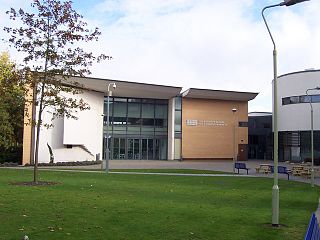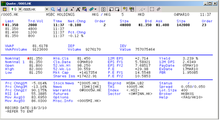A futures exchange or futures market is a central financial exchange where people can trade standardized futures contracts defined by the exchange. Futures contracts are derivatives contracts to buy or sell specific quantities of a commodity or financial instrument at a specified price with delivery set at a specified time in the future. Futures exchanges provide physical or electronic trading venues, details of standardized contracts, market and price data, clearing houses, exchange self-regulations, margin mechanisms, settlement procedures, delivery times, delivery procedures and other services to foster trading in futures contracts. Futures exchanges can be organized as non-profit member-owned organizations or as for-profit organizations. Futures exchanges can be integrated under the same brand name or organization with other types of exchanges, such as stock markets, options markets, and bond markets. Non-profit member-owned futures exchanges benefit their members, who earn commissions and revenue acting as brokers or market makers. For-profit futures exchanges earn most of their revenue from trading and clearing fees.

The Chicago Mercantile Exchange (CME) is a global derivatives marketplace based in Chicago and located at 20 S. Wacker Drive. The CME was founded in 1898 as the Chicago Butter and Egg Board, an agricultural commodities exchange. For most of its history, the exchange was in the then common form of a non-profit organization, owned by members of the exchange. The Merc demutualized in November 2000, went public in December 2002, and merged with the Chicago Board of Trade in July 2007 to become a designated contract market of the CME Group Inc., which operates both markets. The chairman and chief executive officer of CME Group is Terrence A. Duffy, Bryan Durkin is president. On August 18, 2008, shareholders approved a merger with the New York Mercantile Exchange (NYMEX) and COMEX. CME, CBOT, NYMEX, and COMEX are now markets owned by CME Group. After the merger, the value of the CME quadrupled in a two-year span, with a market cap of over $25 billion.

The Bloomberg Terminal is a computer software system provided by the financial data vendor Bloomberg L.P. that enables professionals in the financial service sector and other industries to access Bloomberg Professional Services through which users can monitor and analyze real-time financial market data and place trades on the electronic trading platform. It was developed by employees working for businessman Michael Bloomberg. The system also provides news, price quotes, and messaging across its proprietary secure network. It is well known among the financial community for its black interface, which has become a recognizable trait of the service. The first version of the terminal was released in December 1982.
Reuters Group plc was a British multinational media and financial information company headquartered in London, United Kingdom. It was acquired by the Thomson Corporation in 2008, forming Thomson Reuters, and moved its head office to Toronto.

Electronic trading, sometimes called e-trading, is the buying and selling of stocks, bonds, foreign currencies, financial derivatives, cryptocurrencies, and other financial instruments online. This is typically done using electronic trading platforms where traders can place orders and have them executed at a trading venue such as a stock market either directly or via a broker.

A trading room gathers traders operating on financial markets. The trading room is also often called the front office. The terms "dealing room" and "trading floor" are also used, the latter being inspired from that of an open outcry stock exchange. As open outcry is gradually replaced by electronic trading, the trading room becomes the only remaining place that is emblematic of the financial market. It is also the likeliest place within the financial institution where the most recent technologies are implemented before being disseminated in its other businesses.
Power Plus Pro is a piece of financial software produced by Reuters Group in the form of an add-in for Microsoft Office Excel. A real-time data engine, it pushes new data into Excel when it receives notification of updates from a Reuters TIBCO bus or from Thomson Reuters' RMDS. This commonly involves live market data, such as stock prices, from a financial exchange. Using the add-in, Excel can also contribute information to the TIBCO bus or RMDS; such information then becomes available to other permissioned users using the add-in on another computer or using Reuters 3000 Xtra stand-alone software. Power Plus Pro also has features that allow retrieval of historical market data.
Day trading software is computer software intended to facilitate day trading of stocks or other financial instruments.
MetaStock is a proprietary computer program originally released by Computer Asset Management in 1985. It is used for charting and technical analysis of stock prices. It has both real-time and end-of-day versions. MetaStock is a product of Innovative Market Analysis.

Thomson Reuters Corporation is a Canadian multinational information conglomerate. The company was founded in Toronto, Ontario, Canada and maintains its headquarters in that city's Bay Adelaide Centre.

The International Capital Market Association Centre is a department of the Henley Business School within the University of Reading, based in the English town of Reading, Berkshire. It offers undergraduate, postgraduate and executive education tailored to the capital markets industry.

In finance, an electronic trading platform also known as an online trading platform, is a computer software program that can be used to place orders for financial products over a network with a financial intermediary. Various financial products can be traded by the trading platform, over a communication network with a financial intermediary or directly between the participants or members of the trading platform. This includes products such as stocks, bonds, currencies, commodities, derivatives and others, with a financial intermediary such as brokers, market makers, Investment banks or stock exchanges. Such platforms allow electronic trading to be carried out by users from any location and are in contrast to traditional floor trading using open outcry and telephone-based trading. Sometimes the term trading platform is also used in reference to the trading software alone.
A financial data vendor provides market data to financial firms, traders, and investors. The data distributed is collected from sources such as stock exchange feeds, brokers and dealer desks or regulatory filings.

MetaTrader 4, also known as MT4, is an electronic trading platform widely used by online retail foreign exchange speculative traders. It was developed by MetaQuotes Software and released in 2005. The software is licensed to foreign exchange brokers who provide the software to their clients. The software consists of both a client and server component. The server component is run by the broker and the client software is provided to the broker's customers, who use it to see live streaming prices and charts, to place orders, and to manage their accounts.
FXCM, also known as Forex Capital Markets, is a retail foreign exchange broker for trading on the foreign exchange market. FXCM allows people to speculate on the foreign exchange market and provides trading in contract for difference (CFDs) on major indices and commodities such as gold and crude oil. It is based in London.

Reuters Market Data System (RMDS) is an open market data platform provided by Thomson Reuters. RMDS is used to transport, integrate and manage financial data from stock exchanges and other data sources to end users using multicast or broadcast technology. The underlying protocols are called Reuters Reliable Control Protocol (RRCP) and the Reuters Reliable Messaging Protocol (RRMP)

Quotron was a Los Angeles–based company that in 1960 became the first financial data technology company to deliver stock market quotes to an electronic screen rather than on a printed ticker tape. The Quotron offered brokers and money managers up-to-the-minute prices and other information about securities. The Quotron was developed by Scantlin Electronics, owned by entrepreneur John Scantlin. Scantlin had earlier developed a quotation device that used magnetic tape instead of ticker tape. Quotron's first major competitor was Telerate, which was founded by Neil Hirsch in 1969 and later bought by Dow Jones in 1990.
REDI is Thomson Reuters' EMS platform. Acquired in 2017, Thomson Reuters REDI allows users to access more than 175 execution brokers to route Equities, Futures or Options orders globally, as well as over 20 prime and clearing brokers. According to the company, there are over 5,000 active users of REDI worldwide.
Eikon is a set of software products provided by Refinitiv for financial professionals to monitor and analyze financial information. It provides access to real time market data, news, fundamental data, analytics, trading and messaging tools. It provides data on asset classes including foreign exchange, money markets, fixed income, equities, commodities, funds, and real estate.

Refinitiv is an American-British global provider of financial market data and infrastructure.









